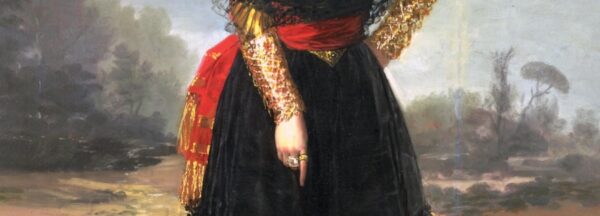
Francisco de Goya y Lucientes (1746-1828), The Duchess of Alba (detail with rings that say “Goya” and “Alba”), 1797, oil on canvas, 210.2 x 149.2 cm, acquired 1907. All works and photographs collection of the HSM&L unless otherwise noted.
Para leer este artículo en español, por favor vaya aquí. To read this article in Spanish, please go here.
Guillaume Kientz, the newly appointed director of the recently renamed Hispanic Society Museum and Library (HSM&L) plans to expand the museum’s mission and outreach. This venerable institution was founded in 1904 by Archer M. Huntington (1870-1955) as The Hispanic Society of America (he habitually referred to it as his “Spanish Museum”) for the “study of the Spanish and Portuguese languages, literature, and history.” It is a unique and important repository of art, books, and documents from Spain, Portugal, Latin America, Goa, and the Philippines. Though initially vibrant, open to the contemporary, and well-funded, it became a somber and insular institution in the latter half of the century.
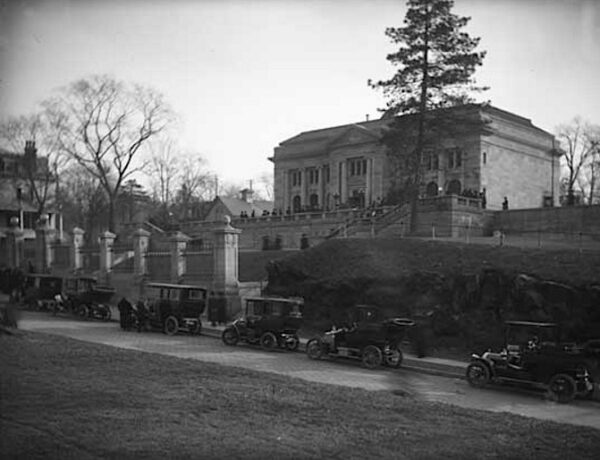
Hispanic Society of America during the Joaquín Sorolla exhibition, which attracted almost 160,000 visitors between February 4 and March 8, 1909, just one year after it had opened. Archer wrote to his mother Arabella Huntington, proudly informing her that the exhibition was a “triumph.”
The Hispanic Society’s endowment became inadequate and buildings needed repair. Moreover, it often gave the appearance of wanting to be cut off from the outside world, and from its mostly-Dominican immigrant neighborhood in particular, like some imperious hidalgo citadel cast adrift in time and space. The institution has worked hard to transform this image, particularly in the last two decades, under Mitchell A. Codding, who became director in 1995 and retired at the end of last year. The HSM&L is dramatically expanding its physical plant, which will augment its permanent collection facilities and enable the museum to host significant temporary exhibitions. It has also embarked on an important acquisitions program — also under Codding’s direction — that includes savvy purchases of works from Latin America that have broadened the scope of the collection. Kientz is a good choice to direct the Hispanic Society as it seeks greater visibility for its remarkable — but still underappreciated — collections. He will also accelerate its efforts to become a more community-, Latin American-, and Latinx-friendly institution. This article looks at Huntington’s founding ideals and objectives; the achievements — both good and bad — of the previous two directors; and Kientz’s background and his goals for the HSM&L.
Huntington Founds a Museum
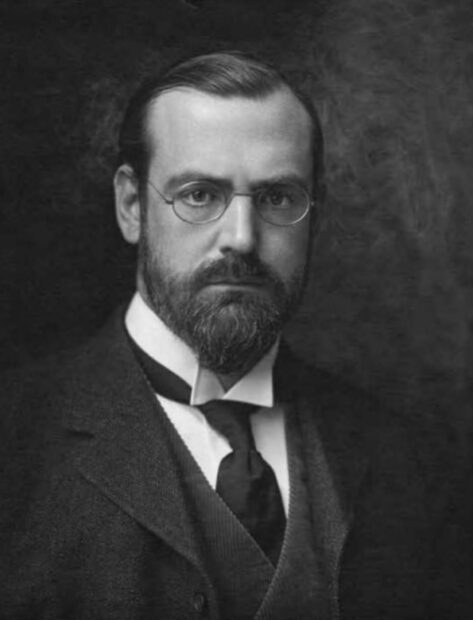
Photograph of Archer M. Huntington, c. 1900, when he inherited $153 million (the equivalent of billions today) from his father Collis P. Huntington, who was a railroad baron. Duveen biographer Meryle Secrest says Collis was ruthless, unscrupulous, and “universally despised.” Archer was a much-lauded philanthropist and supporter of scholarship who gave away nearly all of his wealth during his lifetime.
Huntington’s first contact with Spanish came in the late 1870s at his aunt’s ranch near San Marcos, Texas. His passion was sparked by George Borrow’s book The Zincali; or, An Account of the Gypsies in Spain (1841). He purchased the book in London when he was 12, at which time he wrote in his diary that he would like to live in a museum. The definitive decision to found a museum came during a trip to Mexico in 1889. Activities even included a formal dinner at Chapultepec Castle hosted by Mexican President Porfirio Díaz, the dictator whose refusal to leave office led to the Mexican Revolution two years after the Hispanic Society opened its doors. But the critical factors were Huntington’s immersion in the culture and his contact with diverse groups of people.
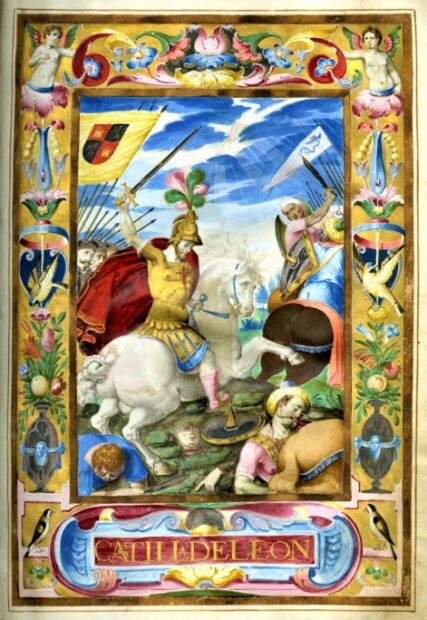
Letters Patent of Nobility of Petitioner Gaspar Guerra del Cañamal, 1610, illumination on parchment, 13 5/8 x 8 7/8 inches, acquired 1933. This bound patent features seven pages of illuminations and the original lead seal. Santiago Matamoros (Saint James the Moor-slayer), the patron saint of Spain, is pictured as a miraculous intervener at the battle of Clavijo. Santiago’s intervention is the most commonly represented scene in the HSM&L’s 16th and 17th century documents. In New Spain (which included Mexico and Central America), the saint was sometimes referred to and represented as Santiago Mataindios (Saint James the Indian-slayer).
While young Archer was obsessing on Spain, the dominant U.S. culture, flush with Manifest Destiny and still influenced by the “Black Legend,” regarded the nation with severe disapprobation. Anglo-Hispanic antipathy had given rise to the “Black Legend,” whereby Spain was regarded as cruel, fanatical, despotic, superstitious, and degenerate. These qualities were sometimes attributed to the “contaminating” influence of African, Moorish, or Saracen blood. In North America, it was alleged that Spanish blood was further degraded by additional mixing in Mexico. An anonymous Anglo-American Texas colonist claimed in a letter in The New Orleans Bee in 1834 that Mexicans were “degraded and vile; the unfortunate race of Spaniard, Indian and African, is so blended that the worst qualities of each predominate.” I treat the conjunction of the Black Legend and Manifest Destiny in my catalogue The Other Side of the Alamo: Art Against the Myth (2018). Racial mixing was often posited as a justification for U.S. imperial expansion.
When Archer and his father Collis visited the American Museum of Natural History in 1891, the museum’s president advised Archer against studying a civilization that was “dead and gone.” On the eve of the Spanish-American War in 1898, Senator Henry Cabot Lodge of Massachusetts had called for war “because we represent the spirit of liberty and the spirit of the new time, and Spain is over against us because she is medieval, cruel, dying…” While Huntington was gathering material for his museum devoted to Spain, Portugal, and their colonial empires, the U.S. seized remnants of Spain’s colonial empire, and thereby became a full-fledged, colony-possessing imperial power.
For an account of U.S. colonization, from the conquest of the western U.S. to the establishment of 800 overseas military bases, see Daniel Immerwahr discuss his book How to Hide an Empire (2019) on Democracy Today.
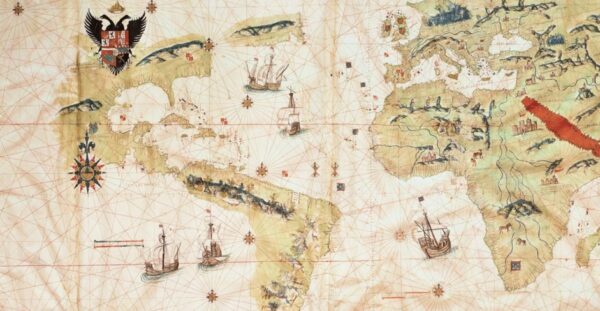
Giovanni (Juan) Vespucci (Florence, 1486–after 1527), World Map (detail), 1526, ink and color on four sheets of parchment, 33 7/16 x 103 1/8 inches, acquired 1914. Juan was the nephew of Amerigo Vespucci (1454–1512). Amerigo was Spain’s first pilot major (based in Seville), responsible for creating and updating a master nautical chart, to be copied for pilots who sailed to the Americas. The Americas are named after Amerigo, who, on the basis of his voyages of 1501-02, recognized that Columbus had reached a separate continent (he didn’t realize there were two continents) rather than part of Asia. Martin Waldseemüller named this territory “America” in his map of 1507. [see: https://www.loc.gov/wiseguide/aug03/america.html.] Giovanni’s map, a luxury copy of the master chart, was likely made to commemorate the marriage of Charles V to Isabella of Portugal in 1526. It depicts recent events, such as the conquest of the Aztecs and Lucas Vázquez de Ayllón’s expedition from Florida to present-day South Carolina (both 1521) as well as ancient beliefs, such as the fall of the Tower of Babel.
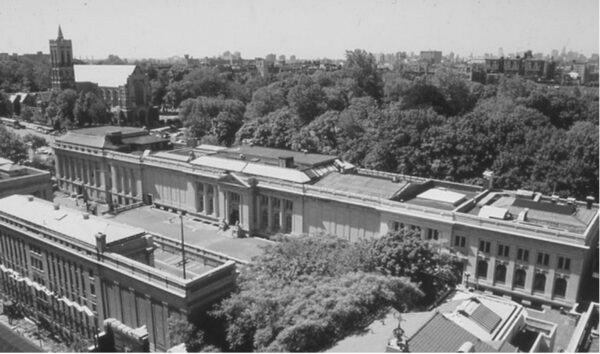
Photograph of Audubon Terrace, off Broadway between 155th and 156th streets in Washington Heights, 1998. The Hispanic Society library is in the center foreground. The museum building is directly opposite, on the other side of the terrace.
Huntington, who founded twelve cultural institutions, was instrumental in the creation of a cultural complex in Audubon Terrace (formerly part of an estate belonging to the naturalist and illustrator John James Audubon) between 155th and 156th streets. It was strategically located near the Broadway (1 Train) subway line. Huntington, who did not foresee the rise of the skyscraper, assumed the city would continue its northward development.
The Hispanic Society was joined by several cultural institutions associated with Huntington, including the American Numismatic Society (1907), the American Geographical Society (1910), the Church of Nuestra Señora de la Esperanza (1912), the Museum of the American Indian—Heye Foundation (1916), and the American Academy of Arts and Letters (1923). Huntington donated the land and paid construction costs for the buildings, except for the church. Archer’s cousin Charles P. Huntington planned the terrace and designed many of the buildings. For the history of Audubon Terrace and Huntington’s role in developing it, see the Keith York City blog and the Hispanic Society Museum and Library “History” section.
An Overview of the Collection

Francisco de Goya, The Duchess of Alba, 1797, acquired 1907; Diego Velázquez, Gaspar de Guzmán, Conde-Duque de Olivares, c. 1625-1626, acquired 1910; José Campeche, Doña María Catalina De Urrutia, 1788, acquired 2013. In this banner image from the HSM&L website, a recently acquired painting by the Puerto Rican artist Campeche is coupled with two foundational acquisitions by Spanish masters, signaling the new direction the art collection has taken.
The Hispanic Society possesses more than 900 paintings, including three by Velázquez. Museums as august as the Louvre and as rich as the Getty have not one autograph painting by this greatest of Spanish masters. The museum also has seven oils by El Greco, and five by Goya, including the signature Duchess of Alba.
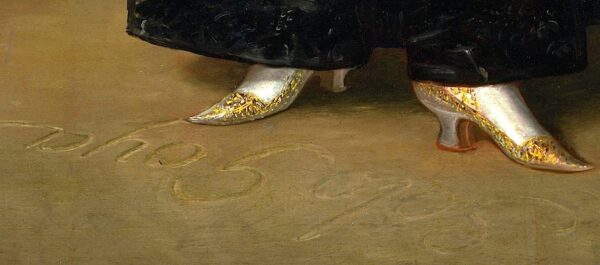
Goya, The Duchess of Alba (detail with “Solo Goya” scratched in the dirt at her feet), 1797. Painted when the artist visited the Duchess’ estate for several months, it was retained by the artist throughout his lifetime. [see: https://projects.mcah.columbia.edu/hispanic/monographs/goya-duchess.php.] Its departure from the classicizing portrait of the Duchess that Goya had painted in 1795 — which remained in the Alba family — marks a shift in the direction of Romanticism. The inscription has inspired much speculation, as well as the historical novel Solo Goya (2006) by Jon Mancip White.
Archer frequently relied on the assistance of artist friends as well as dealers to build the art collection, with mixed results. Arabella and Archer’s cousin Henry married in 1913, reuniting two-thirds of Collis’ fortune. Between 1908 and 1917, they spent more than $21 million on some of the most expensive pictures and furniture money could buy. Some acquisitions — most of which came from Duveen — were extraordinary, such as Rembrandt’s Aristotle Contemplating the Bust of Homer. One sincerely wishes Arabella had meddled more in her son’s museum! Wisely, Archer did pay a steep (for him), though very sub-Duveen, price of $35,000 for Goya’s Duchess of Alba, after the H. O. Havemayers had declined it. Through trial and error, Huntington built a collection of Spanish Golden Age paintings that is still one of the best in the U.S.
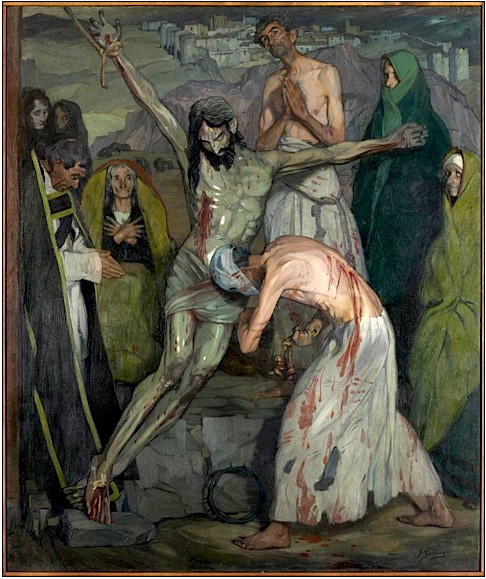
Ignacio Zuloaga (1870-1945), 1908, The Penitants, oil on canvas, 93 11/16 x 75 inches, acquired 1909. This painting depicts self-flagellation rituals that are still practiced today in some areas of Spain during Holy Week.
Contemporary art was an easier field to navigate than old masters. Huntington followed the Sorolla exhibition with one devoted to Zuloaga. While the latter was not nearly as popular as the first, Huntington purchased a number of paintings from the show. Though it is one of his finest works, Zuloaga withheld The Penitants from the exhibition because “I was afraid it would frighten the Americans.” Huntington, who was at pains to present a favorable image of Spain, evidently assented in this unfortunate decision.
Huntington’s most significant commission was Sorolla’s “Vision of Spain,” a suite of 14 paintings almost 12 feet high that stretched 200 feet in length. Painted between 1912 and 1919, they were installed in a custom-built wing in 1926. Between 2007 and 2010, “Visions of Spain” was exhibited in Valencia, Seville, Málaga, Bilbao, Barcelona, and Madrid, where 2.2 million people saw it. The suite was reinstalled at the Hispanic Society in 2010.
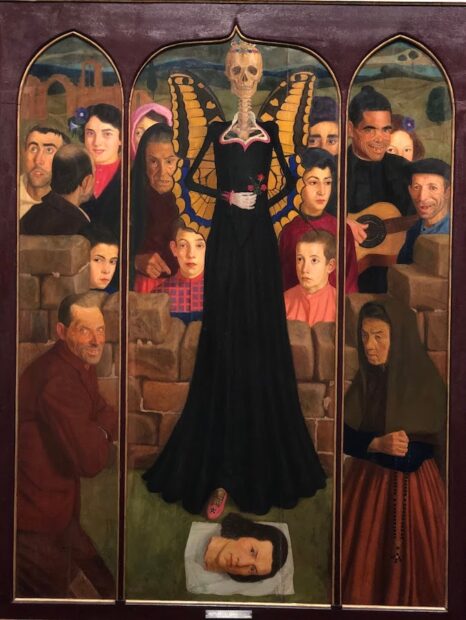
Miguel Viladrich Vilá (1887-1956), My Funeral, 1910, oil on panel, 78 7/16 x 61 1/8 inches, acquired 1927.
When the remarkable self-taught Spanish artist Viladrich Vilá contacted Huntington in hopes of securing an exhibition, the collector purchased all 34 works the artist had brought with him to New York. My Funeral features a butterfly-winged female death figure that stands over the artist’s decapitated head in the center of a mysteriously breached wall. Symbolism is thus imposed over a core of archaizing portraits in a triptych format that references religious altarpieces, complete with parodic saint/donor figures that flank the Madame butterfly of death. I would love to see a show dedicated to this strange, powerful, and highly original artist. (For more works by Viladrich Vilá in the Hispanic Society collection, please go here.) The painting inspired Alejandro Romero, who worked with Siqueiros in Mexico and moved to Chicago in 1975, to make his own allegorical version of My Funeral (collection of the National Museum of Mexican Art, Chicago).
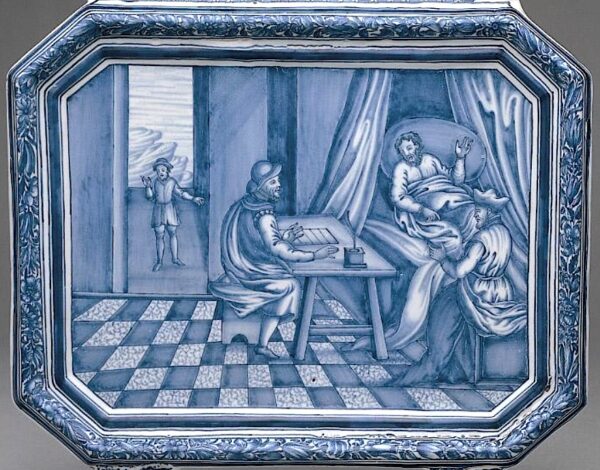
Royal Ceramic Factory of Alcora, “How Don Quixote became Ill, the Testament he made, and his Death,” from Don Quixote by Miguel de Cervantes de Saavedra (1545-1616), c. 1727-49, tin-glazed earthenware, 12 1/8 x 11 1/8 inches, acquired 1999.
The museum owns 175,000 photographs, 15,000 prints (including virtually a complete run of Goya’s prints), 6,000 watercolors and drawings, and 6,000 decorative arts objects. More than 4,000 of its prints relate to Spain’s most famous novel, Don Quixote de La Mancha by Miguel de Cervantes (1547-1616). These prints, coupled with editions of the book and commentaries on it, could form the core of a number of temporary exhibitions. Supplemented by documents from Cervantes’ hand, maps, posters, film clips, photographs, objects from popular culture, stage and opera production costumes and backdrops, etc., these exhibitions could draw audiences whose interests span virtually the entire range of culture.
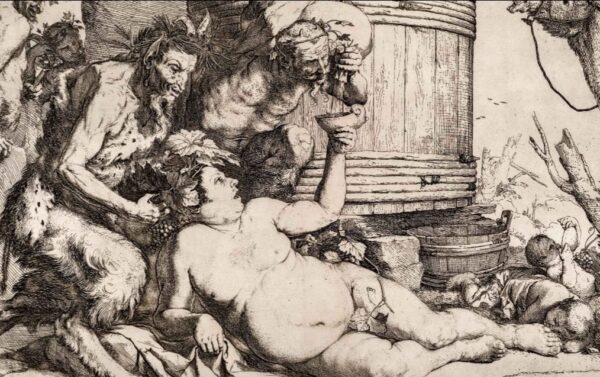
Jusepe de Ribera (called Lo Spagnoletto, 1591–1652), Drunken Silenus (slightly cropped), 1628, etching with drypoint, engraving, and burnishing, sheet: 10 11/16 in. × 14 inches, acquired 1998.
Ribera, who was one of the greatest handlers of paint in the Baroque era, was also the first great Spanish print maker. But he utilized prints to enhance his reputation, and once he reached a suitable level of renown, he quit making them. This print, based on Ribera’s celebrated painting of 1626 in the Capodimonte Museum, was so popular it was published in three editions in the 17th century. Go here for my discussion of the painting, which was featured in last year’s exhibition at the Kimbell Art Museum.
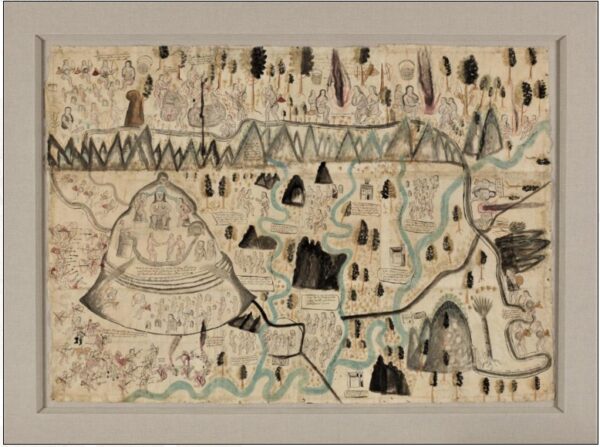
Map of Tequaltíche, 1584, watercolor and ink on paper, 34 x 49 inches, acquired from the Marquis of Jerez de los Caballeros by 1902, it was part of Huntington’s bequest that came to the Hispanic Society in 1956. This map is part of a survey of the Viceroyalty of New Spain ordered by Spanish King Philip II. Indigenous informants answered a questionnaire and produced this map of the village, which is in the present state of Jalisco, Mexico.
The Hispanic Society library has more than 300,000 books and periodicals, as well as 220,000 manuscripts and documents. The foundation of the library was made in 1902, when Huntington — flush with funds from his inheritance — purchased the finest Spanish library in private hands, that of the Marquis of Jerez de los Caballeros in Seville. Thereafter, he relied primarily on the Leipzig-based antiquarian book dealer Karl W. Hiersemann, who assembled and catalogued collections of books specifically for Huntington to buy. Most of Huntington’s purchases were made prior to World War I. While one might assume that books, manuscripts, and documents would make for boring exhibitions, these objects can be dramatically displayed to create thrilling shows. Lux in Arcana, highlights of the Vatican’s secret archive, was a spectacular show held at the Capitoline Museums in 2012. I’ll never forget it. Closer to home, the Morgan Library has produced a number of memorable exhibitions, including Edgar Allan Poe: Terror of the Soul (2013-14) and Painted with Words: Vincent van Gogh’s Letters to Émile Bernard (2007-08).
Treasures on Loan
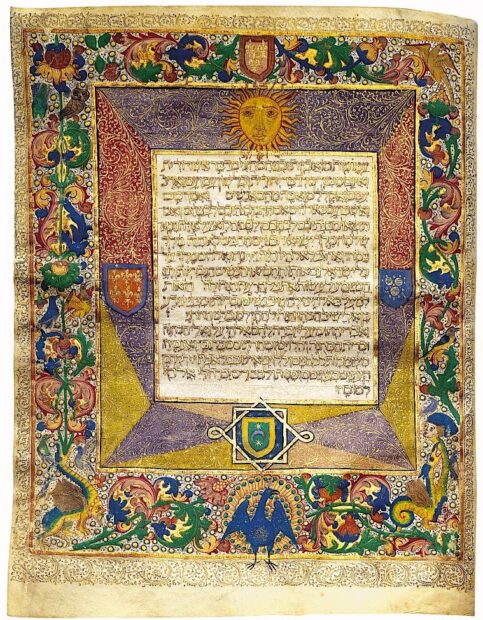
Page from Hebrew Bible, Spain and Portugal 1450-97, illuminated manuscript on vellum, 11 9/16 x 9 5/8 x 5 11/16 inches, acquired by Huntington in 1906, given in 1933. A work of tremendous artistry, this Bible is also a document of intolerance, persecution, and forced migration. Likely created soon after 1450, it was taken to Portugal when the Jews were expelled from Spain in 1492. Between 1492 and 1497, eight illuminated folios were added to it. When the Jews were expelled from Portugal in 1497, it was taken to Fez, Pisa, Florence, Amsterdam, and Hamburg.
The Hispanic Society began actively lending works to exhibitions around the turn of the century (Archer Huntington had banned loans after a work was damaged). The HSM&L has a list of exhibitions, beginning in 2002, to which it has lent art. I am aware of an earlier and very important loan: the three Velázquez paintings were loaned to the Frick Collection in 1999-2000.
The Frick loan, as well as the Hispanic Society’s contributions to the Manet/Velázquez: The French Taste for Spanish Painting (2003) and El Greco (2003-4) exhibitions at the Metropolitan Museum dramatically raised its profile in New York. Codding’s essay on Huntington and the Hispanic Society in the Manet/Velazquez catalogue helped to bring the institution to a gloal audience. (Go here to download the catalogue.)
While the museum building was largely closed for renovations, a group of more than 200 permanent collection works traveled to several museums, starting at the Prado Museum in Madrid in 2017. The exhibition went to Bellas Artes in Mexico City, the Albuquerque Museum, and the Cincinnati Art Museum. It closed at the Museum of Fine Arts in Houston this January, where Codding gave a lecture that serves as a good overview of the exhibition and of the HSM&L’s history.
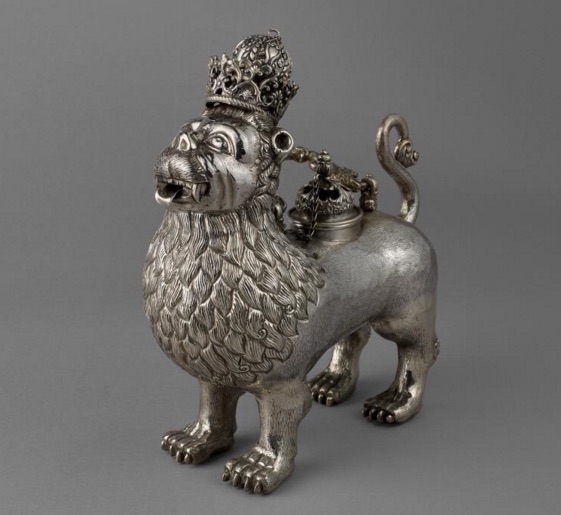
Hot Water Kettle in the Form of a Lion Aquamanile, Peru or Alto Peru (Bolivia), 18th century, silver, 25 × 23 × 11 cm, acquired 2014. Water would be poured into the lion’s head under its hinged crown, and hot coals inserted into its back. Then hot water would be poured out of its mouth into gourd-shaped silver cups, out of which wealthy families would sip yerba maté tea from silver straws. For colonial elites, a mere silver spoon in one’s mouth was déclassé.
This exhibition greatly enhanced national and international knowledge of the museum and its collection. As Codding notes in the catalogue Visions of the Hispanic World: Treasures from the Hispanic Society Museum and Library (2018), a third of the works in the show were acquired in the past 20 years. In my choice of illustrations for this article, I have emphasized seldom-exhibited works, as well as the collection’s increasing diversity, rather than the old master paintings that initially drew me to the museum.
The Hispanic Society Under the Two Previous Directors
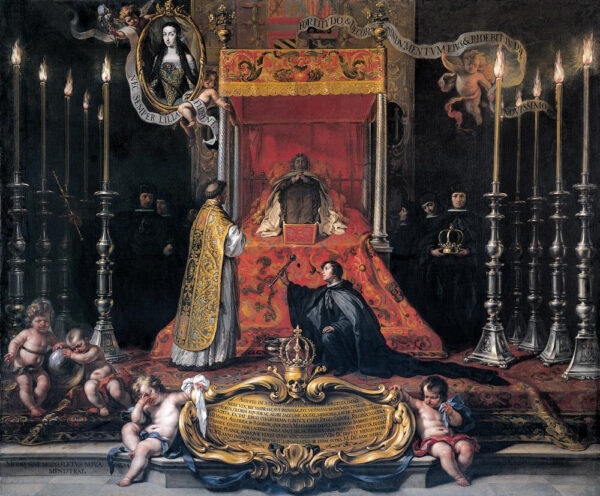
Sebastián Muñoz (1654-1690), Maria Luisa of Orléans, Queen of Spain, Lying in State, c. 1689-90, oil on canvas, 81 ½ x 99 7/16, acquired 1913. Wearing the Carmelite nun’s habit in which she was buried, the queen lies in state in Madrid’s Alcázar Palace. A gilded skull crowns the cartouche in the foreground.
I visited the Hispanic Society often, beginning in 1980, when its hostility to Latinx visitors and communities was palpable. Virtually every quip I remember from a museum official was cringe-worthy, if not infuriating. On one of my first trips, a curator staffing a kiosk with dusty old catalogues asked me where I was from. When I told her I was from the U.S., she said: “Your Spanish must be really bad.” Perhaps I wouldn’t have been the only visitor in the museum at that time, had the museum staff been less inhospitable.
The New York Times reported in 1989 that annual attendance had declined to 10,000 (from 35,000 in the late 1960s and 50,000 in the 1950s), and that the museum “lies low and likes it.” It neither lent nor borrowed art, its library’s archaic regulations made scholarship difficult, and it was philosophically opposed to signage, publicity, and raising money.
Perhaps the nadir of antagonistic museum commentary came in a 1993 interview with Robin Cembalest in Art News. Theodore S. Beardsley Jr., who had been director since 1965, decried what he called the local community’s “low level of culture.” He was subsequently chased across the Audubon Terrace courtyard by demonstrators, who chanted “Beardsley, racista!” Cembalest also reported that Hispanic Society president George S. Moore, the retired chairman of Citibank — who assuredly recognized redlining when he saw it — characterized the museum’s neighborhood as “non-taxpaying slums.” (I always picture Moore singing along with Eva Gabor on the Green Acres “give me Park Avenue” lyric.)

Portable writing desk, c. 1684, Pasto, Colombia, barniz de Pasto lacquer on wood with silver leaf, modern yellow metal hardware, 7 ½ x 14 3/16 x 12 inches, acquired 2001. The bishop of Popayán commissioned this desk for his brother, who was secretary to King Charles II. Its structure recalls Japanese lacquer cabinets, and its decoration fuses indigenous, Asian, and European elements.
A 2003 New York Times article notes the lifting of loan restrictions, the development of children’s programs, and an increase in attendance to 20,000. Writer Julie Salamon insightfully pointed out that colonialism was a point of tension between the Hispanic Society and the Latinx community: “Many locals are Spanish-speaking but not generally interested in the art of the conquistadors, tending to be descendants of the conquered.” While Salamon is right to point out that they do not generally identify with conquistadors, Caribbean immigrants have a much higher percentage of Spanish genes than immigrants from Mexico, Central America, and the Andes, where largely indigenous communities survived. A recent study in Nature (reported in the New York Times) found that, on average, people in Puerto Rico are 14% indigenous, while in the Dominican Republic they are 6% indigenous, and only 4% indigenous in Cuba.
In 2006, the Times reported that Codding made the ill-advised decision to move the institution downtown. Fortunately, the move never transpired. He instead annexed a building that formerly housed the Museum of the American Indian, which was used primarily for storage. In 2012-13, Codding sold off a collection of nearly 38,000 Iberian and Spanish colonial coins assembled by Huntington. Formerly on loan to the National Numismatic Society, he said they were not technically part of the Hispanic Society’s permanent collection. Though full auction results were not publicly disclosed, the collection had a presale estimate between $25 and $35 million, and a single coin sold for $681,539.
A 2011 New York Times article, “An Outpost for Old Spain in the Heights,” notes that the institution was considering naming itself after its founder. The director of the Dominican Studies Institute at City College of New York, Ramona Hernández, spoke to the Times of a “new age” of cooperation, as she prepared early maps of the Dominican Republic for online presentation. Codding, meanwhile, justified the continued exclusion of contemporary art: “the basis of this collection is old master and 19th-century art.” That comment belies Huntington’s very active and enthusiastic engagement with contemporary art, as noted above. Michael Mowatt-Wynn, president of the Harlem & the Heights Historical Society, is quoted at the end of the article: “They’ve got to make up for 100 years… How do you do that overnight?” The inclusion of Latin American colonial art was a very good first step, but only a first step.
Senior Curator Marcus Burke, in a filmed interview with Miguel Perez of the Bronx Journal in 2013, recognizes the local Dominican community as an asset rather than an affliction. He speaks glowingly about the education program of the Museo del Barrio (located on the East Side in Spanish Harlem), and he notes the Hispanic Society’s improved education efforts in the last five years. Burke says the museum’s collecting purview includes the present day U.S. Southwest (as part of Latin America), but implicitly not the rest of the country. This demarcation reflects the colonialist mentality present since the institution’s foundation: only that which was formally colonized by Spain and Portugal — and literally part of its empire — is considered relevant to the collection. While Huntington’s conception of his “Spanish” museum was very broad for its day, it should be made more expansive.
I inquired about the Hispanic Society’s recent education and outreach programs. Prior to its closure for renovations in 2017, it held classes in the museum building, except for the Drawings of the Hispanic Society program, which was held at participating schools, where all subsequent instruction has been held. An in-classroom Young Curator program was inaugurated in 2019, with a graduation ceremony on Audubon Terrace. A virtual Summer Camp program was conducted via zoom in July of 2020 in conjunction with several other uptown Manhattan institutions. The HSM&L segment features workshop footage taught by Education Department staff (Cristina Domenech, Ryan Pinchot, and Maria del Carmen Barney) along with local artists.
The museum has hosted many concerts, beginning around 2004. It initiated a formal annual Concert Series in 2010 to promote Spanish and Latin composers and musicians. (Go here for the 2020-2021 Concert Series listing.) This season is devoted to the North American premiere of the opera Apolo y Dafne (c. 1696-99) by Sebastián Durón (1660–1716) and Juan de Navas (c. 1650–1719). The museum recently hosted a Zoom conversation with stage director Guillaume Bernardi and artistic director Elizabeth Weinfield, who will stage the opera later this year.
The musical program has included recitals, chamber groups, etc. by renowned musicians and composers, as well as performances by local modern ensembles such as Sonnambula, La Camareta de Washington Heights, and Meridionalis. Events have been held in the Main Court gallery (whose architecture is inspired by the Vélez Blanco patio at the Metropolitan Museum), in the Sorolla “Vision of Spain” gallery, and outdoors on Audubon Terrace.
The HSM&L website, which was dismissed by the New York Times in 2003, is now substantial and up-to-date. The HSM&L has also initiated a “Tertulias de Arte Hispano” program on Youtube hosted by board chair Philippe de Montebello. He engages in discussions with curators, conservators, and librarians that explore aspects of the HSM&L’s collection. Programs to date have included chocolate dishes, Don Quixote prints, the conservation of sculptures by Luisa Roldán (the HSM&L has the world’s largest public collection of her works), and Latin American photographs. Live programs are accessible only to donors, but past programs can be accessed here.
Guillaume Kientz: Exhibitions and Training
Kientz, who has an MA degree in political science, two MA degrees in art history, and many publications to his credit, served for two years as the Curator of European Art at the Kimbell Art Museum in Fort Worth, Texas. I made his acquaintance when I reviewed the Flesh & Blood exhibition at the Kimbell last year. When I asked Kientz why he left the Louvre for the Kimbell, he cited his admiration for American museums, particularly “their outreach programs and the commitment of their patrons and communities.”
Kientz had been the Curator of Spanish, Portuguese, and Latin American Art for more than nine years at the Louvre, in which capacity he curated several important, groundbreaking exhibitions in Paris.

Installation shot of “Le Mexique au Louvre” with Saint Philip of Jesus, anonymous 17th century statue (Metropolitan Cathedral, Mexico City). Photo source: Guillaume Kientz.
Co-curated with Jonathan Brown, La Mexique au Louvre (2013) was a partnership between the Louvre and Fomento Banamex. Kientz says he and Henri Loyrette — then the Louvre’s director — wanted to “blaze a trail for Latin American art at the Louvre.” The exhibition featured mostly large-scale 17th and 18th century paintings from Mexico, which were hung side-by-side with the Louvre’s Spanish paintings. Kientz sought to correct French misconceptions and prejudices by “proving that the Mexican school can bear comparison with masterpieces from the Spanish school.” He calls the experience “life changing” because it afforded him the opportunity to travel extensively in Mexico. I was astonished when I came across this exhibition at the Louvre, which began with a statue normally in the Cathedral of Mexico City. Despite the Louvre’s conservative reputation, I couldn’t imagine a major U.S. museum doing this kind of exhibition. Kientz also collaborated on another Latin American exhibition at the Fourviéres Museum in Lyons, France, mostly of art from the Andean region.
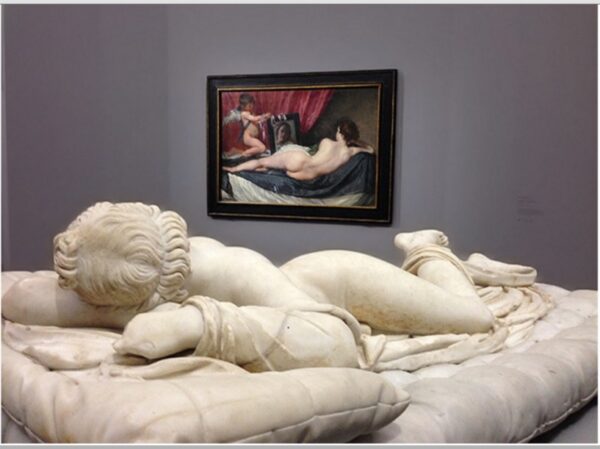
Installation shot of “Velázquez” exhibition at the Grand Palais, with Venus with a Mirror (London National Gallery) and Borghese Hermaphrodite (Louvre Museum). Photo source: Connaissance des Arts.
Despite Velázquez’s enormous influence on progressive 19th century artists — especially Manet — there had never been a French exhibition devoted to him before Kientz’s Velázquez in 2015, which was held at the Grand Palais. With many works by Velázquez’s contemporaries, this comparative exhibition sought to clarify as well as contextualize Velázquez’s oeuvre, particularly at the beginning and end of his career. It showed how Velázquez developed a highly realistic style in Seville before he encountered Caravaggist paintings in Madrid. He endeavored to define the artistic personality of Juan Bautista Martínez del Mazo, who, says Kientz, was previously “a trash bin for pictures ‘not good enough to be by Velazquez.’” Kientz secured eight paintings from the Prado, as well as several important but rarely loaned works, such as the ferocious Portrait of Pope Innocent X (1650) that obsessed Francis Bacon, and the artist’s only surviving nude, the complex and enigmatic Venus with a Mirror (c. 1649-51). It was situated adjacent to a probable source, the famous Borghese Hermaphrodite, which is the first time these works were brought together. (For the latter’s connection to and influence on Bernini in Rome, see my article“Apollo and Daphne: A Tale of Cupid’s Revenge.”)

Installation view of “Greco” at the Grand Palais, Paris, with Fray Hortensio Félix Paravicino (Museum of Fine Arts, Boston); The Assumption of the Virgin (Art Institute of Chicago); Cardinal Niño de Guevara (Metropolitan Museum of Art); exhibition design by Véronique Dollfus. Photo source: © RMN-Grand Palais 2019 / Photo Didier Plowy.
Greco, the first large-scale monographic exhibition devoted to El Greco in France, was held at the Grand Palais. It was co-curated by Rebecca Long in partnership with the Art Institute of Chicago, its other venue. The exhibition emphasized El Greco’s early years as a Byzantine artist more than the last two El Greco retrospectives held in Washington (1982) and New York (2003). Kientz says he “explained how Domenikos Theotokopoulos became El Greco.” Most of the Paris exhibition was arranged thematically (Portraits, Toledo, Sculpture, Architecture). El Greco’s creative process, says Kientz, “is based on a dynamic tension” between invention, repetition, and variation, exemplified by four versions of The Purification of the Temple featured in the exhibition. The last gallery, devoted to El Greco’s late years, showed how El Greco’s paintings served as a bridge to multiple forms of modernism.
The Hispanic Society Museum and Library’s Future Prospects
After the triumphant Sorolla and Treasures exhibitions, the HSM&L has received unprecedented publicity, its treasures are newly restored, and its facilities are enlarged and improved. It regards its Spanish-speaking community in an affirmative manner. In short, the HSM&L seems invigorated, and ready to finish breaking the mold specified by its founding charter in order to more fully engage with the modern world and become a fully modern museum.
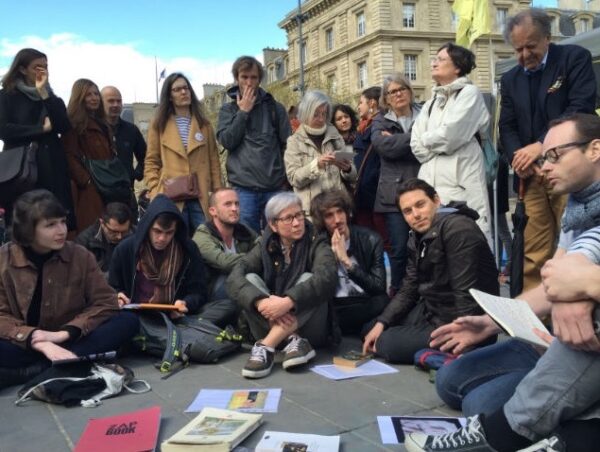
Musées Debout outdoor exchange (Kientz is on the extreme right). Photo source: Marie Cambolieu, Inspirelle.com
HSM&L board chairman de Montebello emphasizes Kientz’s “knowledge and passion about Spanish and Latin American art,” as well as his “deep commitment to working for more diversity and a more inclusive and relevant conversation about art,” exemplified by his leadership of a movement initiated in Paris in 2016 “to re-imagine museums in less traditional ways.” (Go here for an English language article on the Musées Debout Mouvement.)
I began discussions with Keintz as soon as his appointment to the HSM&L was announced in mid-December. When I brought up the fraught history of the museum’s relation to the local community, Kientz replied that it was not “what it could and should have been.” He wants to build on the positive efforts made in recent years, noting there is always room for improvement. He adds: “I can assure you that the present staff is quite committed to it and that I will make this a priority right on the top of my list of concerns.” His goal is to “start this adventure on an optimistic and positive note.”
I also noted that Hispanic Society officials had previously opposed Latinx exhibitions by artists born in the present-day U.S., saying they did not want to compete with the Museo del Barrio. But a number of other New York institutions (MoMA, Brooklyn, Queens, and hopefully the Metropolitan) will host Latinx shows, without any danger of an excess of such exhibitions. Moreover, the HSM&L wouldn’t turn down Spanish or Latin American shows with the excuse that it didn’t want to compete with the Frick, Metropolitan, or Brooklyn Museum.
Kientz emphatically favors acknowledging, recognizing, and including Latinx artist in HSM&L exhibitions: “I totally agree with you on the exhibitions and scope that we should cover. The core of the collection is historically Spanish or, to be more accurate, ‘Iberian.’ That does not mean that we cannot explore, acquire, and exhibit works from other cultures and countries. Quite the opposite! Especially — and for obvious reasons — in the case of the arts from Latin America. This includes of course U.S.-born artists of Latin American descent, and among them local talents that live in Washington Heights.”
Kientz elaborates further on global issues pertaining to the “Iberian” and the “Hispanic”: “What fascinates me about Hispanic art is that it provides an entrance door to the entire world. In the early modern period, the ‘New World’ was closely connected not only to Spain, but also to Italy (Naples, Milan, Genoa, etc.), to France, and obviously to Northern Europe. The Iberian Peninsula was, at the same time, a crossroads, a receptacle for cultures, a catalyst, and a cultural broadcaster.”
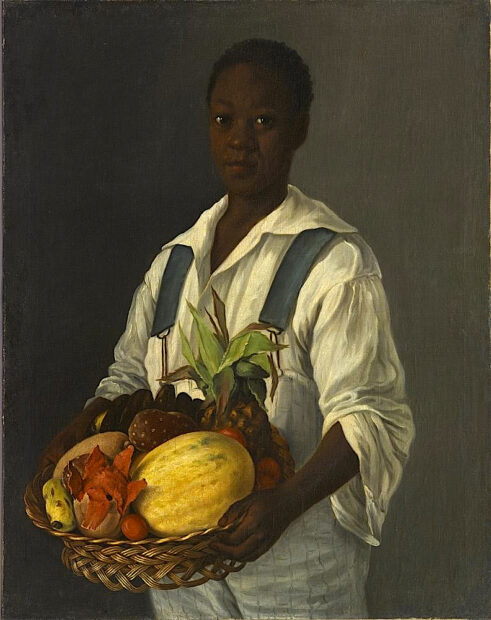
José Agustín Arrieta (1803-1874), El Costeño (The Young Man from the Coast), after 1843, oil on canvas, 35 1/16 x 27 5/16 inches, acquired 2013. El Costeño is the most important of the Latin American paintings acquired by the HSM&L, one that took a year to obtain permission to export from Mexico. Arrieta was trained at the Puebla (Mexico) Academy of Fine Arts, which was not as stultifying as the Royal Academy in Mexico City. His work shares the directness of the finest popular paintings, rather than the conventions and stereotypes that plagued so many academically trained Mexican artists. The young man is clearly of African descent, presumably from the Veracruz area, where the once-large Afro-Mexican community has since blended into the general population. This painting is the subject of a Tertulia featuring Senior Curator Markus Burke.
I intended to ask Kientz whether he would be willing to take on difficult but centrally relevant issues, such as colonialism, slavery, and genocide. He answered before I could ask: “Similarly — and in fact as a consequence of Spain’s central role in early modern history — Hispanic art is also a relevant substrate for studying and addressing major tragic issues of Western civilization, such as slavery, colonialism, persecution, and gender inequity.”
Kientz wants to “involve and showcase Latinx artists,” whether “from the local scene or from afar, whether born in Latin America or born in the U.S.,” in the form of “solo shows, programs, or in interaction with the permanent collection.” He calls this “an opportunity not to be missed.”
Expanding on his vision of the HSM&L, Kientz wants it to be “a place rooted in Washington Heights and open to the world, a place where things happen. I am very excited about it, as you can imagine. I see a huge potential. The collection is incredible. The collections — I should say! They cover a very large and varied scope of techniques, periods, and geographical origins.”
Kientz is also enthusiastic about the architecture and the plaza: “The building itself is a landmark monument, a perfect example of the Beaux-Arts/New York Renaissance style, and the plaza is a fantastic space that waits for imaginative uses.”
I asked Kientz if he had any immediate plans that he could share. The coronavirus epidemic has upset the museum’s timetable, and he is reluctant to talk about ideas for Latin America, Spanish, or Portuguese exhibitions that he has not had a chance to discuss with the staff and the board. But he can share some ideas and plans. The HSM&L is negotiating potential exhibitions from its permanent collection with several European and U.S. museums. Kienze elaborates: “…the collection is so large that we will continue to partner with other museums and offer collaborations so that the collection is more broadly accessible and the institution is more visible throughout the country.”
In terms of exhibitions at the HSM&L, Kientz hopes two Latinx shows will be presented in the spring/summer of 2021, both in collaboration with the Northern Manhattan Arts Alliance. Latinx Diaspora: Stories from Uptown, which will be outdoors on the Broadway Terrace, consists of four large, free-standing murals by Carlos J. Martinez, Dister, Danny Peguero, and Maria-Carla Torres. They address Latinx emigration from the aftermath of the Spanish-American War to post-Hurricane Maria (2017). They were inspired by HBO documentary on Luis Miranda, Jr., Siempre Luis.
The other show, In the Heights, is an exhibition of photographs documenting the behind-the-scenes making of the yet-to-be-released Warner Bros musical In the Heights (2019), based on Lin-Manuel Miranda’s stage show and directed by Jon M. Chu. (The film trailer is available here.) It will be held in the HSM&L’s East Building. These exhibitions are an ideal way to continue the museum’s decolonizing process.
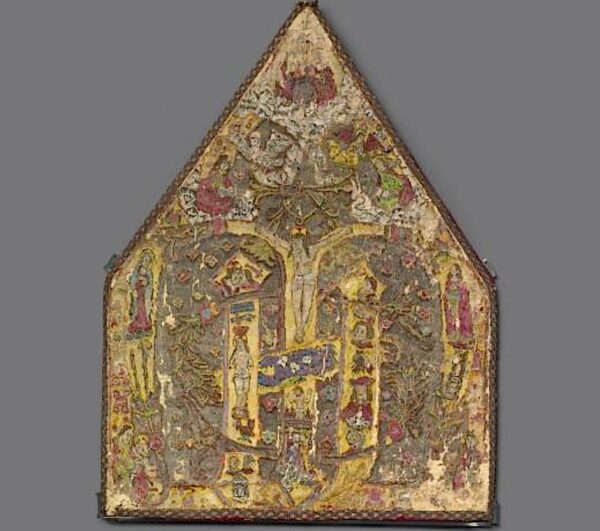
Feather Mosaic Bishop’s Miter with the Crucifixion in the Monogram of Christ, c. 1560, Feathers on amate and maguey paper, gold, cotton, glue, silk border and inside lining, Michoacan (Patzcuaro), Mexico, 43.9 x 10.5 cm, acquired 1980. This miter was fashioned out of feathers, which were more valuable to Mesoamericans than gold. The Spanish compelled indigenous craftsmen to renounce their religion and to utilize their traditional skills in the service of the Catholic church. This miter is one of seven that Charles V, King of Spain and Holy Roman Emperor, gave to other European rulers and important prelates. All of the other miters from this group are in European churches or museums, including the Pitti Palace in Florence.
I would like to see the museum go a step further. It should collect and borrow pre-contact indigenous material as well. Just as a relatively small number of Latin American colonial-era objects permit the museum to represent this vital aspect of art and culture, so, too, would a number of judiciously chosen objects give representation to pre-Hispanic cultures. This is especially important because Spanish contact immediately had devastating, genocidal consequences. This is particularly true of the Caribbean. Why not collect and exhibit works by the Taíno, the indigenous peoples of the Caribbean? Boricua College, mentioned above as one of the tenants in Audubon Terrace, is named after the word the Taíno used for Puerto Rico.
Archer Huntington, we should remember, was instrumental in securing the Museum of the American Indian-Heye Foundation, a world-class collection, as the Hispanic Society’s next-door neighbor. Its founder, the omnivorous collector George G. Heye, was Huntington’s close friend. Heye had already amassed 400,000 objects when the museum was incorporated, and the collection more than doubled. With characteristic generosity, Huntington provided a publications fund and land for a storage facility in the East Bronx, as well as the land and building on Audubon Terrace. That building — which the HSM&L has annexed — still bears a frieze with the inscribed names of Indian tribes. Perhaps the HSM&L could even borrow pre-contact works from its previous neighbor, which is now called the National Museum of the American Indian, and is part of the Smithsonian Institution. Its primary facility is in Washington D.C. For the story of the move, see Roland G. Force, Politics and the Museum of the American Indian: The Heye and the Mighty (1999). Force, the museum director who engineered the relocation, notes that Collis Huntington’s intercontinental railroad “sounded the death knell for the Indians of the West” (as autonomous entities, in any case), just as the fortune it created provided for the museum’s first home.
“Hispanic” is a problematic word for many Latin American and Latinx institutions and groups, since it is often associated with the conquest of indigenous peoples in the Americas. Including indigenous material in the collection would be a way of acknowledging indigenous cultures in their own terms. Otherwise, one perpetuates the impression that indigenous cultures become important and noteworthy only after they have been conquered and converted.
If, for example, the museum borrowed or bought a pre-Hispanic feather mosaic, wouldn’t that serve to illuminate the post-conquest miter? Wouldn’t the artistic, cultural, and historical significations of the miter be broadened through juxtaposition with a pre-contact feather work that might be only 40 years older? Pre-Hispanic objects are necessary to tell an unvarnished and representative story of the complex interactions between the cultures of Europe, the Americas, and the rest of the world. Huntington celebrated the glories of Spain. Its Golden Age, of course, was made possible by the gold, silver, and other valuables brought from the Americas.

Double wick lamp with mask of Pan, c. 0-100 A.D., Roman period Spain (Málaga), bronze, 10 ¼ x 9 9/16 inches, acquired 1913.
The HSM&L has the best collection of Spanish archaeological material outside of Spain, commencing with an important group of Bell Beaker ceramics c. 2400-1900 B.C. It also has a remarkable hoard of 22 Celtiberian objects fashioned out of silver, gold, and electrum, c. 150-72 B.C. The Treasures catalogue rightly compares the lamp illustrated above to the finest bronze objects excavated at Pompeii and Herculaneum.
Huntington used Iberian archaeological material that pre-dated the Spanish language, as well as Judaic and Islamic artifacts and documents, in order to tell the story of Spain. (Many of the finest Islamic objects were put on long-term loan to the Metropolitan when it opened its new Islamic galleries in 2011.) If we want to understand the complex world in which we live — as honestly and completely as possible — we should consider all the relevant material that shaped it.
The museum, for instance, should tell the story of how the Spanish and Portuguese disseminated food from the Americas to numerous parts of the world, which enabled many locales to have adequate nutrition for the first time. It also provided the variety of foodstuffs that enabled the development of national cuisines. The museum should also tell the story of how these foods were first developed and cultivated in the Americas before European contact. I have treated this subject in a book chapter: “Indigenous Heritage, Culinary Diaspora, and Globalization in Rolando Briseño’s Moctezuma’s Table” (Moctezuma’s Table: Rolando Briseño’s Mexican and Chicano Tablescapes, 2010). The museum’s collection affords many points of entry to this story, including maps, dishes and utensils, cookbooks, etc.
The devastating diseases brought from Europe, as well as race-based slavery, are likewise part of the story of the Hispanized world. The work of border-crossing artists who make critical explorations of hybridity, such as Coco Fusco, Enrique Chagoya, Guillermo Gómez-Peña, and the late James Luna would also be illuminating.

The Fates of Man: Death, Soul in Hell, Soul in Purgatory, Soul in Heaven, Manuel Chili (1723-1796), known as Caspicara, attributed to, c. 1775, polychrome wood, variable: approximately 9 x 12 x 10 inches, acquired 2016. A testament to the creativity of its maker, this expressive set of four small sculptures from Quito has no exact counterpart in Europe or Latin America.
Sometimes it is the Spanish side that needs more telling. The Spanish were so effective in eradicating indigenous cultures that archaic Spanish customs are often mistaken for indigenous ones in connection with Day of the Dead, as I have argued in Glasstire. It would be illuminating to have more research conducted on Spanish traditions, and it would benefit the many groups and institutions that commemorate and study Day of the Dead. I would guess that the library already possesses a wealth of material that could illuminate this topic. Incidentally, a number of works illustrated in this article would fit well into Day of the Dead exhibitions.
Kientz also wants to commemorate — in one way or another — the 50th anniversary of Picasso’s death in 2023. Though he was the most important creator of 20th century art, Picasso is in many ways already an old master. He is easily the most important Spanish artist since Goya — and he certainly deserves a larger place in the new HSM&L. He is already represented in the collection as an illustrator of Cervantes.

Plate with Jonah and the Whale, c. 1600, Talavera de la Reina, Toledo, Spain, tin-glazed earthenware, 6.2 × 40.7 cm., acquired 2015.
Kientz regards the HSM&L as today’s “most exciting museum adventure.” As for the galleries, he anticipates a gradual process of openings. He explains: “We’ve lost time with Covid. My intention is to bring cultural life back to the HSM&L as soon as possible, hopefully as soon as this spring.” The institution is poised for a dramatic re-launch that could rival its original opening.
****
Ruben C. Cordova is an art historian who has curated more than 30 exhibitions, most recently The Day of the Dead in Art at Centro de Artes (San Antonio, 2019-2020). He moderated a discussion of “Love and Death in Times of Pandemic” with altar-builder David Zamora Casas (Bihl Haus, San Antonio, December 2020). Cordova served on a Zoom panel with Enrique Chagoya via the Wadsworth Atheneum Museum of Art (Hartford) in January. He is on a panel treating Latin American Art Nomenclature in conjunction with the exhibition No Ocean Between Us: Art of Asian Diasporas in Latin America & the Caribbean, 1945-Present, scheduled for March 5 at the San Antonio Museum of Art.


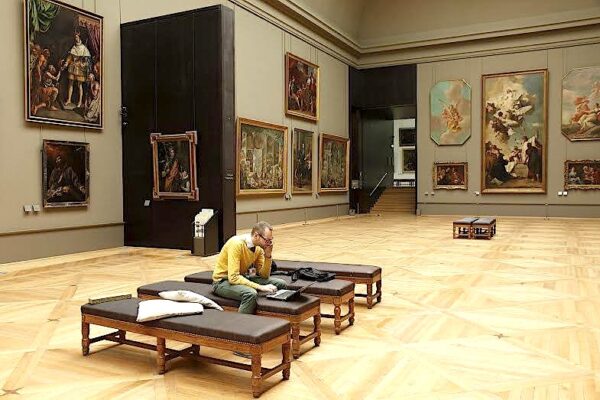

6 comments
How wonderful to hear about all the plans afoot at this extraordinary institution. Let’s hope that they also make the library more accessible. Even to scholars, it still remains one of the least welcoming places, run as if it is for the use only of those who work there.
What a fine article with so much information, a wide-ranging context, exciting links, and powerful suggestions for the future of the museum.
Increased access would be a very good development, New York Scholar.
Thank you, Chale. I enjoyed the opportunity to reflect on the institution and its future.
Such a fascinating in depth article. We will miss Guillaume.
Many of the most important paintings (and a few sculptures) in the Hispanic Society collection are still at the Museum of Fine Arts, Houston, where they will be on view through the end of the year.